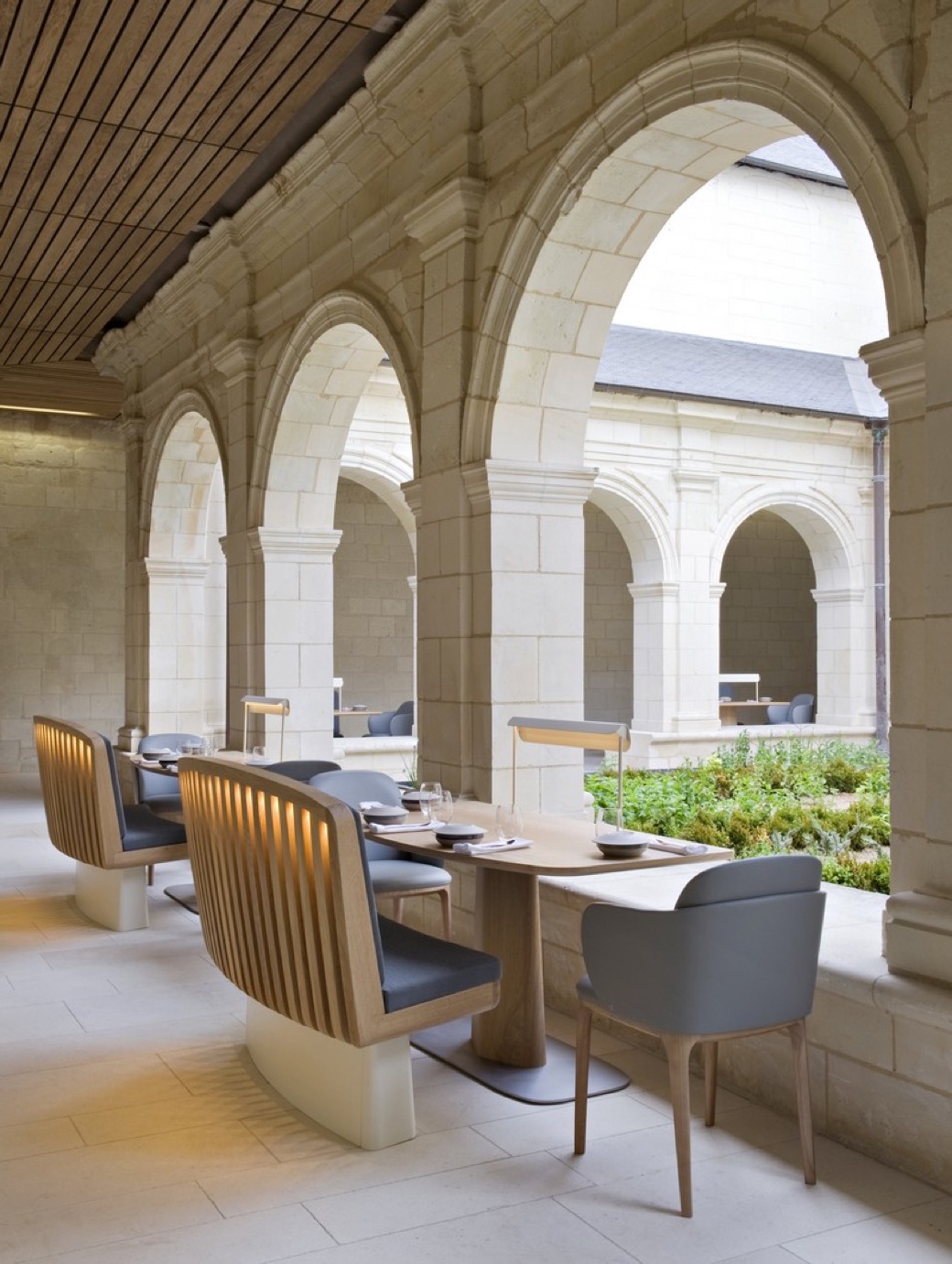Abbaye Royale de Fontevraud
last update: 20 Nov. 2019

Introduction
In one of our trips south we stopped over in Fontevraud l’Hotel, a 4-star hotel situated inside the walls of l’Abbaye Royale de Fontevraud. This abbey is in fact included in the UNESCO World Heritage Site N° 933 and is described as ‘The Loire Valley between Sully-sur-Loire and Chalonnes’ (as shown below). The Abbey is said to be one of the largest monastic cities in Europe.
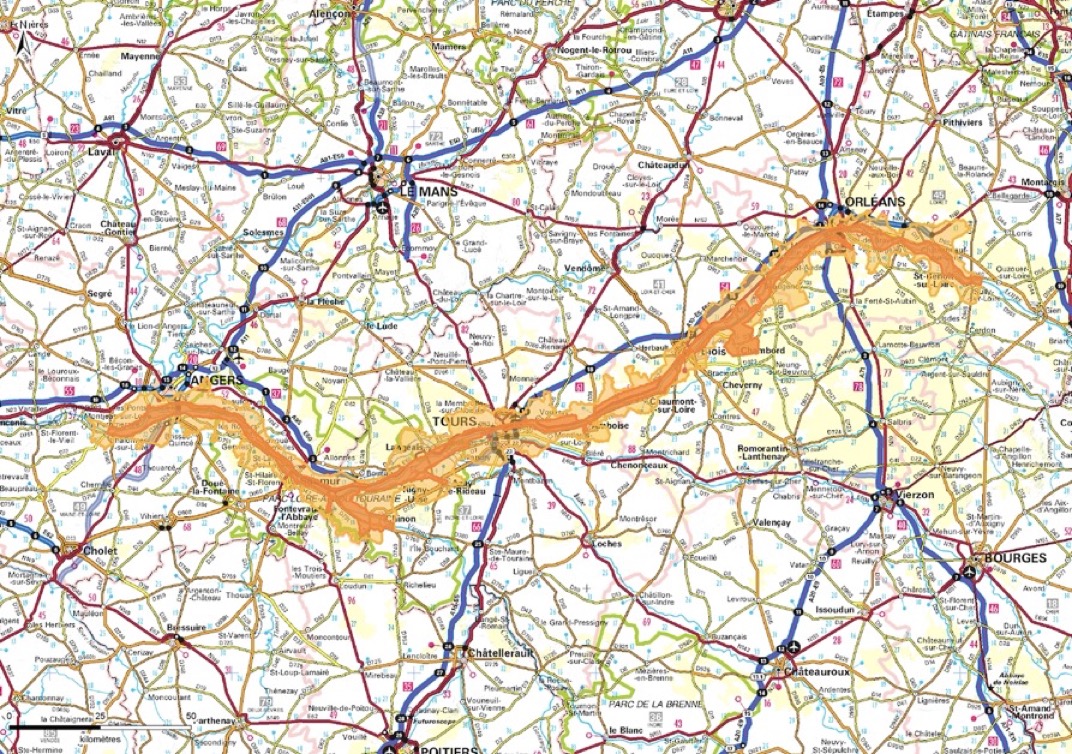
The Wikipedia article is a useful starting point but does not really convey the size and scope of the site (the French Wikipedia article is much more detailed).
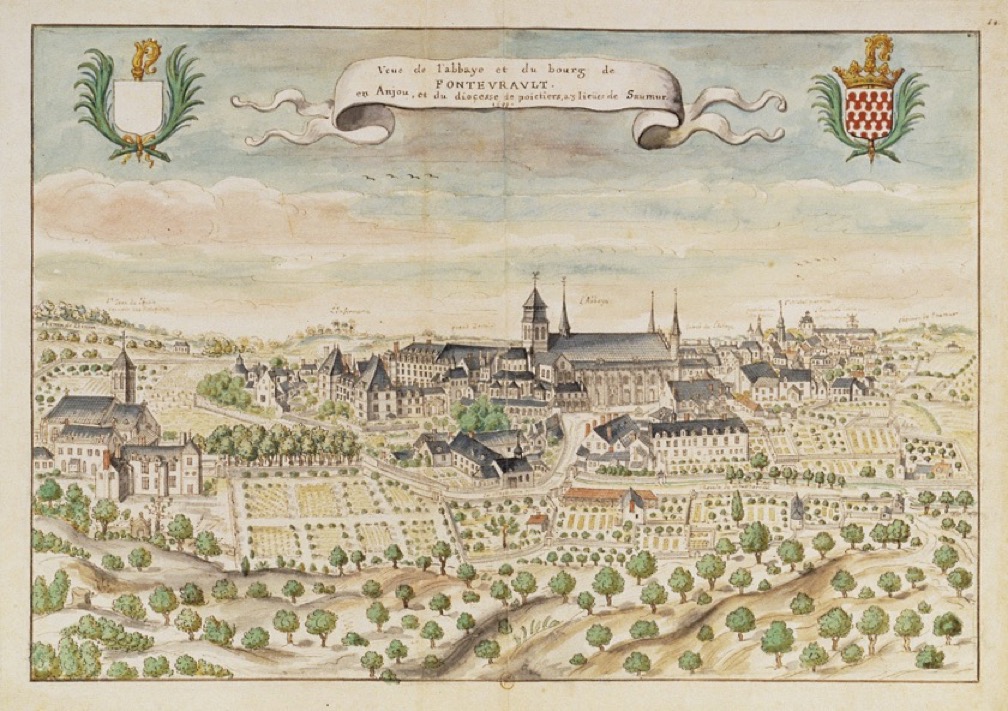
History of Fontevraud
The key moments in the history of this abbey are:
Founded in 1101 by Robert d’Arbrissel as the seat of the order of Fontevraud (rules of chastity, obedience, silence and poverty)
The first buildings were built in the first quarter of the 12th century
Initially the order was based upon the practice of syneisaktism, an ascetic practice that consisted of the chaste cohabitation of people of different sex in order to overcome carnal temptations
With the building of the abbey cohabitation was transformed into a ‘double order’ with the men in one monastery building and the women in a different building
Sisters were to be more then 10 years old, and Brothers 15 years old
Nuns were to be at least 14 years old, and Monks 18 years old
The cloister was seen as a walled area with no openings except one locked door
Nuns and monks were not allowed out, and others not allowed in (except occasionally family in ‘long and decent clothes’)
What we see today with the St. Mary’s Cloister and the Saint-Lazare Priory were for the nuns
The monks occupied the monastery of Saint-Jean-de-l’Habit, which no longer exists
Poverty was the only way to root out the ‘vice’, and each person was given ‘dresses, veils, blankets, socks, breeches, boots, tools, needles, threads, and other things necessary to cover themselves night and day, or to do the manual work'
The originality of Fontevraud resided in the fact that it was one of the few mixed orders to have been led by a woman, in fact this position of the abbess as ‘caput ordinis’ was enshrined in numerous papal bulls
At the death of Robert d’Arbrissel, the order had already 35 priories, bringing together two thousand men and women (including the Abbey of Amesbury established in 1177)
Each monastery would have a ‘cellérière’ to account for and look after food and drink (and the distribution of food to the poor), a ‘dépositaire’ to account for all gold, silver, and cloth received and spent, a ‘boursière’ to account for all monies received and spent, a ‘chambrière’ who would look after ‘tablecloths, shrouds, baskets, vestments both old and new, and all the other things that are necessary for the beds, for the use at the tables, and for manual work’, and a ’sacristaine’ to look after ornaments, vessels and sacred relics
The order of Fontevraud had neither the influence nor the power of Cluniac (Benedictine) or Cistercian orders, but they were one of the richest orders in France due to being exempted from taxes, enriched by gifts, by the revenues of woods, fields, farms, mills and tolls, by tithes, Royal and Sovereign gifts, and the pensions and dowries of young women and men who entered the order
The abbey became the necropolis of the Plantagenets with the death of Henry II in 1189
In 1199 the abbey became the resting place of Richard the Lionheart
Aliénor (Eleanor of Aquitaine), wife of Henry II, was buried there in 1204, as was their daughter Joan in 1199
At the end of the ‘Plantagenet Empire’, after 1214, the abbess found it increasingly difficult to feed 700 people living and working in the abbey
The ‘Plantagenet Empire’ closed in continental Europe with the conquests of Philippe Auguste, but the houses of Lancaster and York held the English crown through to 1485
The wealth of the order varied much, for example in 1249 Raymond VII left a considerable gift to the abbey when he was buried next to his mother Joan (some reports suggest that it was the largest gift ever made to a religious order)
There are stories about the abbess Marguerite de Pocey who is said to have welcomed by 1297 more than 5,000 nuns (it is said that she exchanged her rents on her fisheries, mills, and houses for a fixed supply of wheat)
During the Hundred Years’ War (1337-1453) in 1369 the rents of the abbey dropped by 60%, and more than 500 nuns had to return to their families, whereas the remaining 500 nuns had to take on local work to survive (the Pope finally decided to consolidate the rents of the different abbey’s so as to keep Fontevraud open)
In order to help the abbey survive it is said that it received a fragment of the Holy Thorn from the crown of thorns of Christ
Marie de Bretagne (daughter of Richard d’Étampes and Marguerite d’Orléans, and cousin of Louis XII) entered the Abbey of Longchamp at the age of 14 after the death of her husband Pierre de Rieux in 1439 (he was 50 years old when he died in prison), and in 1459, after becoming abbess of Fontevraud, she reformed completely both the finances and spirituality of the order
Starting in 1491 the Bourbon royal family provided five abbesses, who were able to both reform the order and make substantial changes to the site of Fontevraud
The first was Renée de Bourbon-Vendôme, 4th daughter of Jean VIII, who built the walls around the abbey (against the will of the nuns who being poorly fed often escaped to their families over night)
In 1507 François, Count of Angoulême (who would later become François Ier) was seriously hurt by a stone thrown by a monk in protest at the building of the walls
The main dormitory was funded by Catherine de Médicis in 1567
In 1670 the abbey was home to 230 nuns, 60 monks, and 47 other staff
In the same year Marie-Madeleine-Gabrielle Adélaïde de Rochechouart de Mortemart became abbess and Fontevraud entered a prestigious period thanks to the fact that she was the sister of Madame de Montespan, maîtresse en titre of Louis XIV (and thus administered water, forests, and the cutting of wood under the authority of the King)
Between 1738 and 1750, the four younger girls of Louis XV stayed at Fontevraud where the King entrusted them to the education of the nuns (the girls were Victorie, Sophie, Thérèse-Félicité, and Louise who later died of smallpox)
In 1765 Fontevraud, with is 52 priories, remained the richest abbey in France and Louis XV exempted the abbey from subsidies, taxes and ‘gabelles’ (a tax on salt)
With the French Revolution, the property of the clergy is declared national property in 1789
By 1792 the abbey was empty and divided into lots and sold, the last abbess Julie Sophie Gillette de Pardaillan de Gondrin (daughter of Louis de Pardaillan de Gondrin) was obliged to flee and take refuge with friends
In 1793 the abbey was looted and ransacking, the sarcophagi and coffins broken and the bones thrown away
In 1794 several martyrs of the order were taken to Paris and guillotined for counter-revolutionary plots
In 1804, Napoleon I signed a decree that transformed the abbey into a prison, as well as the abbeys of Clairvaux and Mont Saint-Michel
Fontevraud remained a prison from 1812 through to 1963, and was exclusively for men after 1850
Known as “the prison of a thousand and one windows and doors” because of its inadequate prison architecture, Fontevraud was considered one of hardest prisons in France
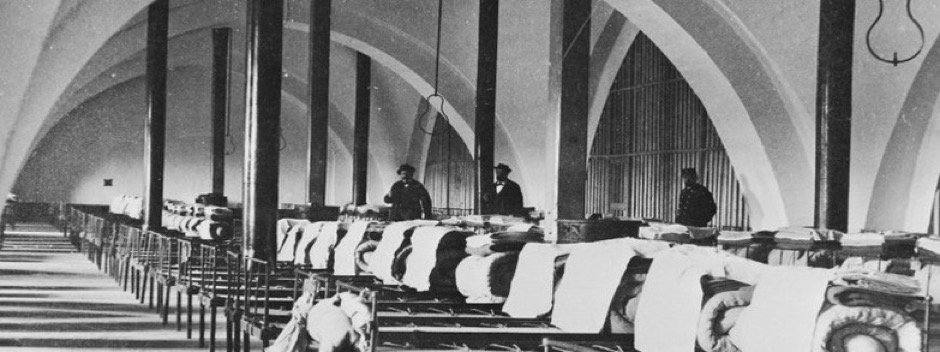
Designed to accommodate 1,000 inmates, the prison receives up to 2,000 prisoners in the 1830’s and employed 150 guards
Despite being a prison, the abbey still appeared on the first French national list of historical monuments published in 1840
From 1975 the site has undergone restoration as both a museum and cultural complex.
Checkout this site for a more in depth description of the history of Fontevraud. A complete list of the abbesses can be found here.
And here we have an excellent video ‘1000 ans d’architecture en 4 minutes’ which shows how Fontevraud evolved from 1101 through to the present day. Vimeo hosts FontevraudTV with 66 other videos.
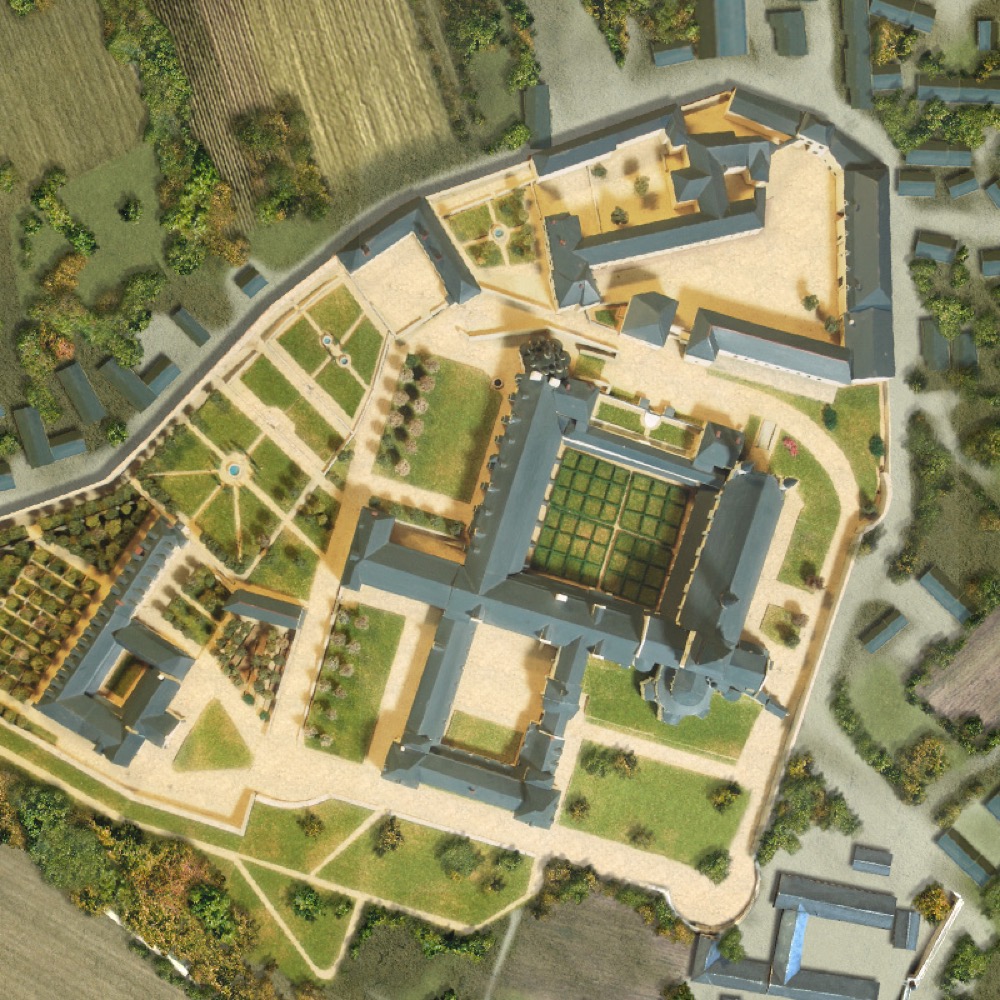
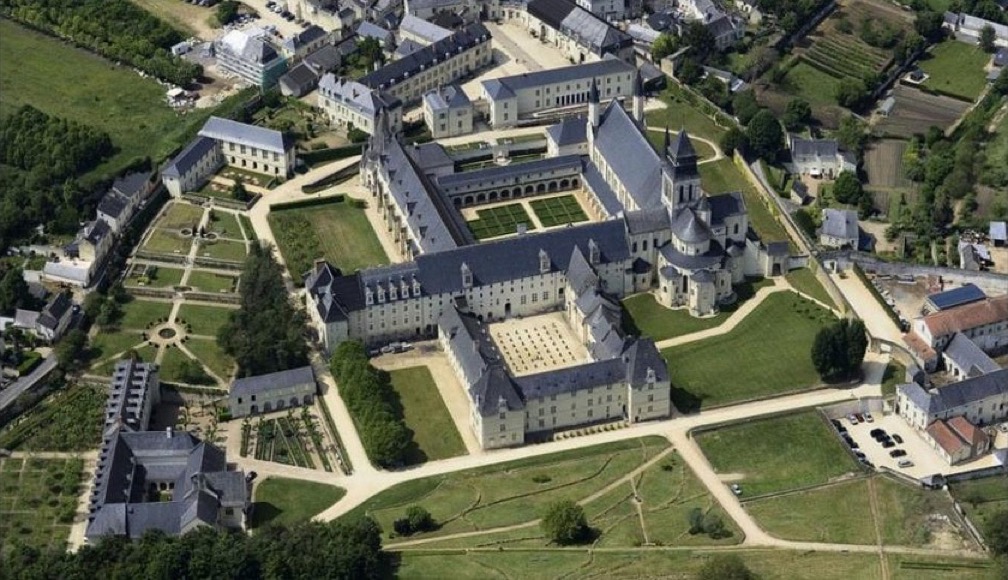
We can see the main body of the abbey with the large grassed Cloître Sainte-Marie (St. Mary’s Cloister), with the Abbatiale (Abbey Church) on the right side, and the Réfectoire (Refectory) on the left (with the unusual Cuisines (Kitchens) attached at the back).
The Abbey Church, often called Notre-Dame, is about 90 meters long and was completed shortly after it was consecrated in 1119. The abbey is also often called the monastère du Grand-Moûtier, which is a bit odd since the word moûtier just derives from the latin monisterium.
The large cloister is the centre of the monastery, providing access to the abbey, the chapter house (salle capitulaire), the refectory, the kitchens, and the dormitories.
The cloister is 59 meters alone its sides, and was rebuilt in 1548.
The square of grass to the left of the refectory is called the gardens of the noviciate, and the wing that extends to the left was the dormitory of the novices. I have also seen this dormitory called the ‘grand dortoir’ and the garden the ‘pelouses de réfectoire’.
The smaller stone-floored courtyard is home to the Chapelle Saint-Benoît (St. Benedict’s Chapel) on the right, which was the chapel attached to the Infirmerie (Infirmary). The original 12th C infirmary was rebuilt in the mid-16th C, and was only attached to the main cloister sometime around 1700. Infirmary was meant to accommodate sick or elderly nuns who were no longer able to maintain a ‘regular life’. During its time as a prison, the chapel was transformed into a brewery.
The grass square bordered by St. Benedict’s Chapel and the ambulatory and three apsidiole’s (apse-chapels) of the Abbey Church was originally the nuns cemetery.
In the bottom right-hand corner is the old Couvent de la Madeleine (Madeleine Convent). This convent appeared to be still under restoration, and was the parking area for the hotel.
The hotel and restaurant itself is in the Prieuré Saint-Lazare (Saint-Lazare Priory), in the lower left-hand corner. Originally dedicated to the treatment of lepers, it was later rebuilt ca. 1150 in a style called Gothique Angevin, often characterised by deep rounded convex vaults. At the end of the period termed the Ancient Régime (ending 1792 with the French Revolution), the priory was used exclusively for the treatment and convalescence of the nuns. During its period as a prison the priory became the infirmary. The triangular grass patch was originally called the Garden of Lebanon (for patients to take the air), and the planted area next to it was called the Garden of Simples (or herb or medicinal garden, where a ’simple’, from the Latin ‘singula plica’, was an herb used on its own in medical treatment). Behind the priory (far lower left corner) was the apple orchard of Saint-Lazare.
At the back we can see the Logis Abbatial (Abbey’s Manor) and something called the Fannerie (which I think are the stables). We can also see the terraced gardens and the orangery of the abbess.
The land at the front was home to the prison factory and a special high-security area, and the prison workshops were built over the abbess gardens and orangery (see below). We do know that the prisoners made mother-of-pearl buttons, gloves, nets, blankets for the army and also processed hemp and flax.
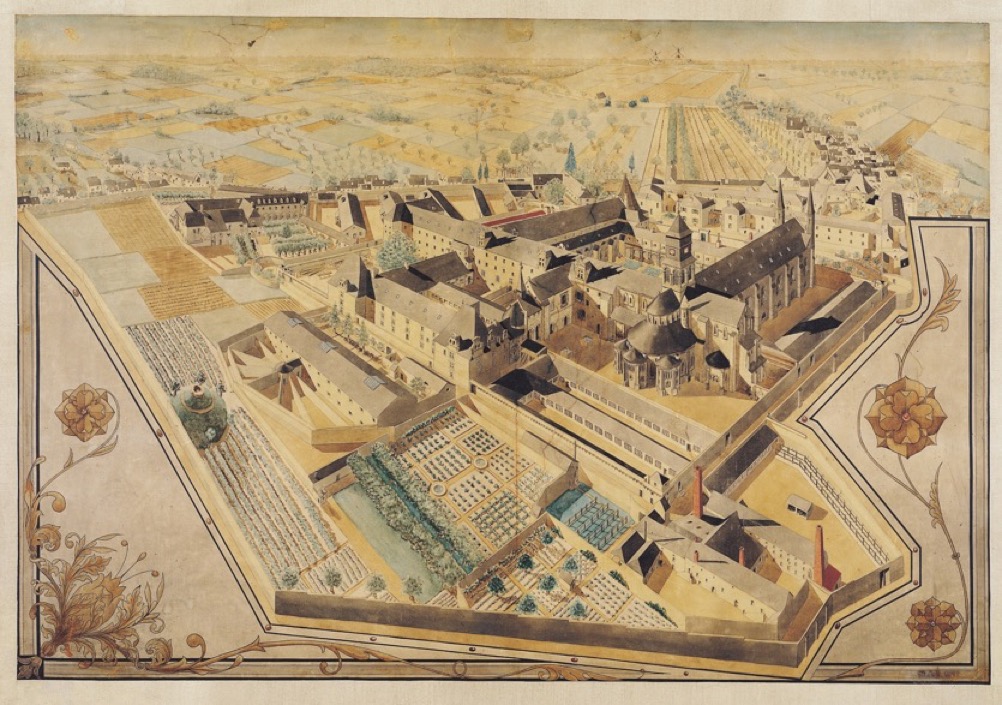
The Visit
Our visit will start with the below view of the grass square bordered by the ambulatory and three apsidiole’s (apse-chapels) of the Abbey Church and the small St. Benedict’s Chapel (withs its small spire). The larger building on the left was the infirmary. My understanding is that the grassed area was originally the nuns cemetery.

We will go around the site to the right to find the entrance façade to the Abbey Sainte-Marie (Saint Mary). It is a simple façade with triangular gable, 4 double buttresses, two octagonal towers, and a Romanesque door.
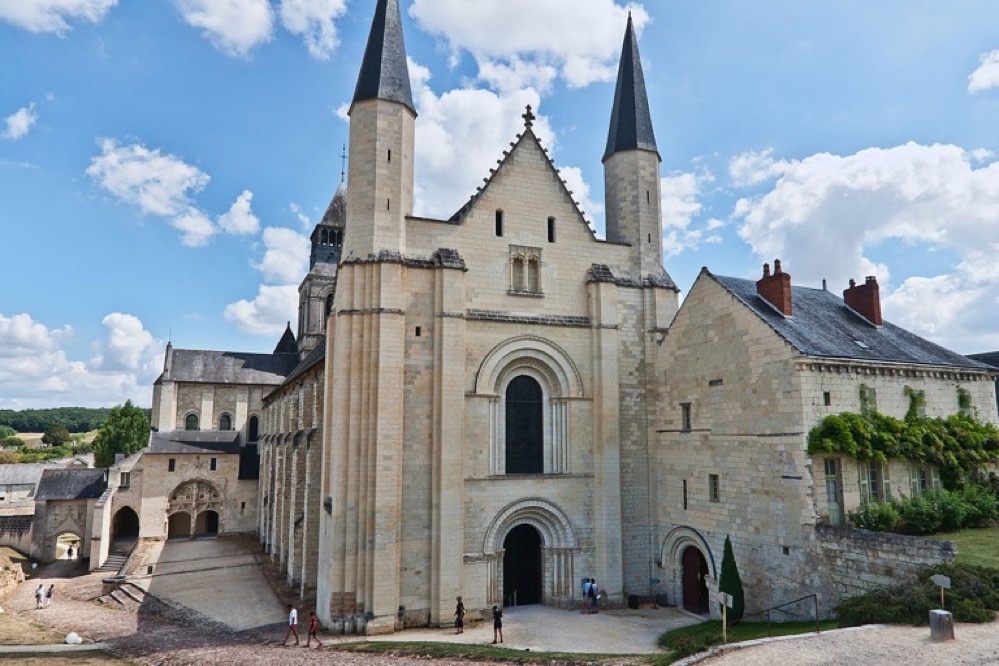
The abbey is a very classical design with a long nave, a substantial transept, ending with a sanctuary (choir) around which runs an ambulatory with three apse chapels. It is said to have been built before 1115, by a local master, and with little ornamentation. The overall appearance is one of a slender, sober church designed to give a strong impression of simplicity and spirituality. The central square tower over the transept was finished in the 17th century.
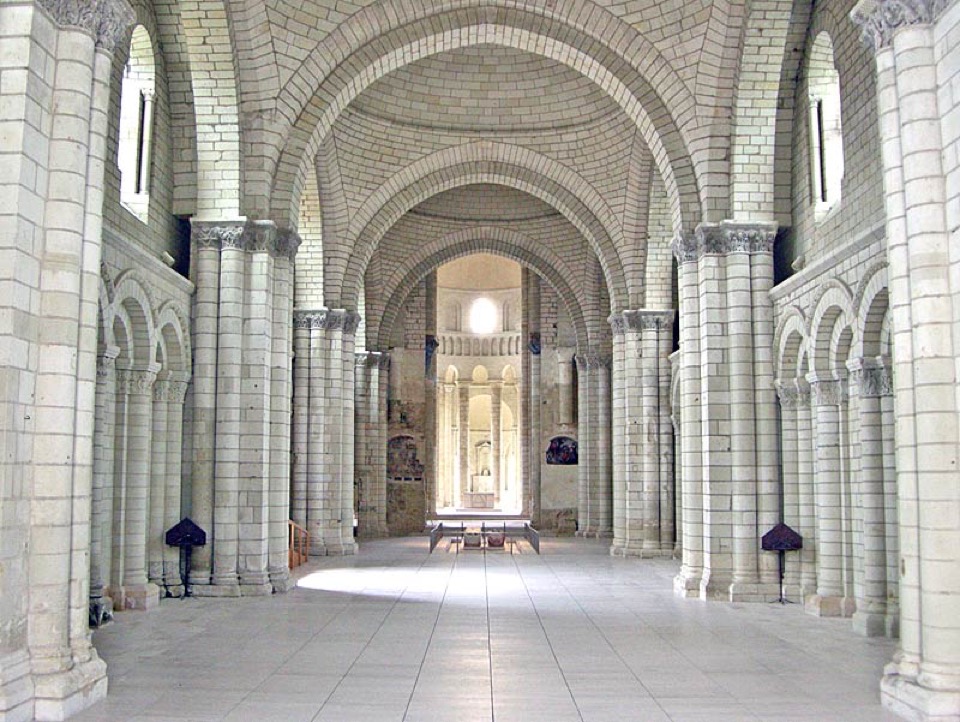
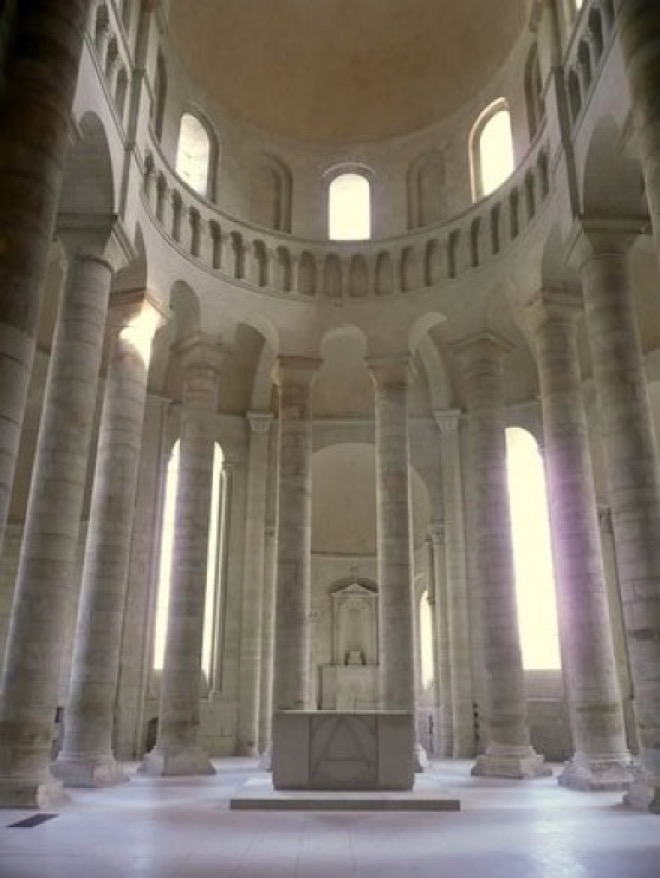
In the nave is the so-called ‘Cimetière des Rois’ (Cemetery of Kings) with four sculptured figures ‘gisant’, tomb monuments depicting recumbent effigies of the deceased. Originally they would have been near the transept, but they were moved in 1504. The four are Henry II (1133-1189), his wife Eleanor of Aquitaine (1122-1204), Richard Lionheart (1157-1199), and Isabella of Angoulême (1186-1246), wife of John, the youngest of the five sons of Henry II.
In addition the original recumbents of Joan of England (1165-1199), the seventh child of Henry II, and her son Raymond VII (1197-1249) were later replaced by so-called ‘orants’, or effigies standing or kneeling in pray. These effigies were destroyed during the French Revolution.
So today, only four remains are left exposed in the nave of the abbey church. They have their eyes closed and rest on a bed, their heads on a cushion. The white shirt, a red tunic, a blue coat of Henry II and Richard symbolise the Trinity. They were girded with the crown, the scepter and the sword, symbols of royalty. Eleanor, dressed in a white dress with supple and graceful folds, holds an open book which is a unique representation for a ‘gisant’.
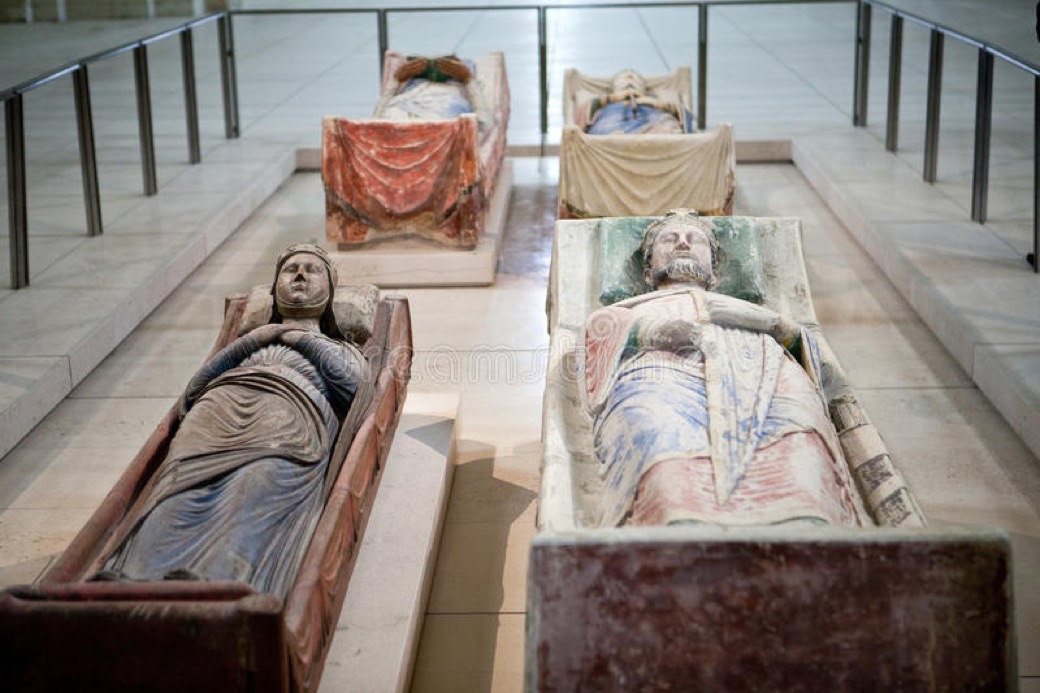
Three of the four recumbent, larger than life (well over 2 meters tall), are carved in blocks of local Tuffeau limestone and probably date from 1204. Isabella is smaller, with her diadem, her blue dress, her grey tunic adorned with gold, her hands crossed on his chest, and is one of the oldest known ‘gisant’ carved all in wood (dates from the middle of the 13th century). As with all recumbent effigies they are presented as young and serene, there is usually no attempt to cast a real portrait. In 1866, Napoleon III thought to offer them to Queen Victoria but there were too many protests.

Adjoining the abbey church is a 15th C cloister (the original Romanesque cloister has completely disappeared). It is 56 meters long on the sides E and O and 59 meters on the sides N and S, and was in fact built in two stages. The South wing was built in 1519, just after the construction of the refectory. The West wing (originally built before 1597) was completely rebuilt in the 19th century. The East wing (1548-1551) opens on to the chapter house through an important central door. The North wing (built around 1560) is the only wing covered with a tiled roof, the others support a covered gallery.
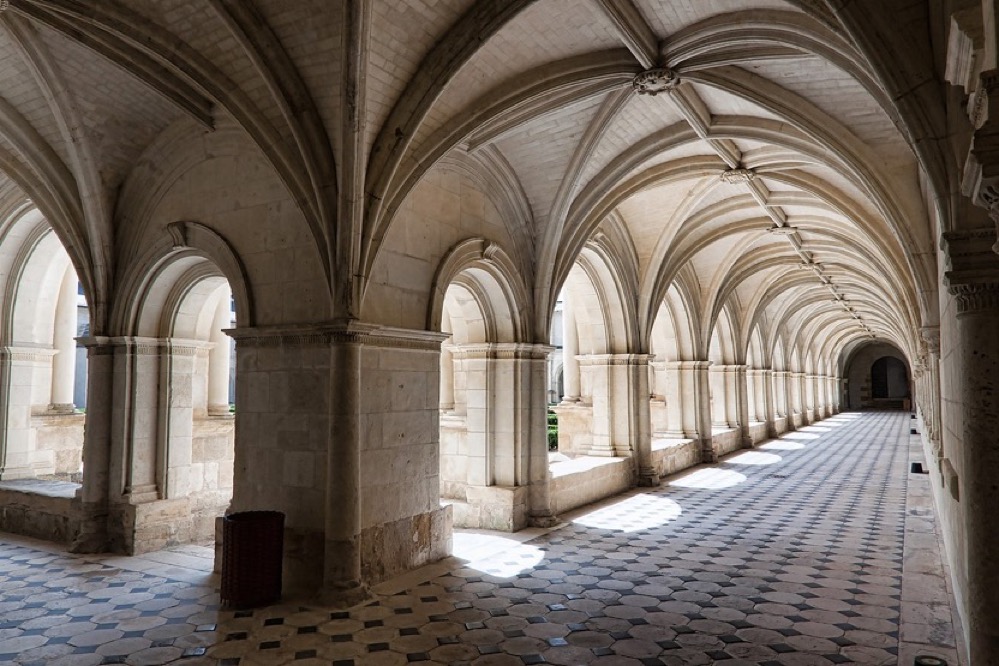
The East wing (1548-1551) opens on to the chapter house through an important central door.
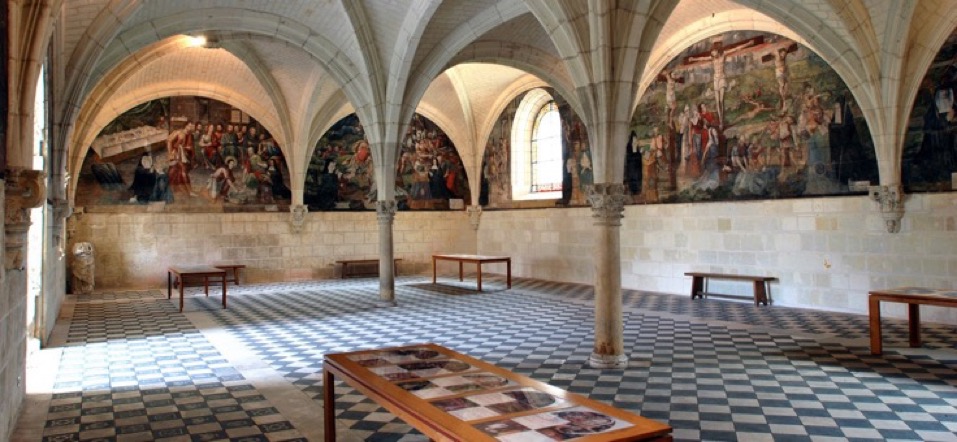
The semicircular panels describe on the wall ten semicircular arches framing murals. these frescoes were painted by the Angevin Thomas Pot around 1570. They represent scenes from the Gospel, such as the Last Supper, the betrayal, and the coronation of thorns. In all the scenes there are nuns, and it is thought that they are portraits of nuns that actually lived at that time (it is also possible that they were added later). The portraits of Renée and Louise de Bourbon are found in the scene of the Crucifixion.
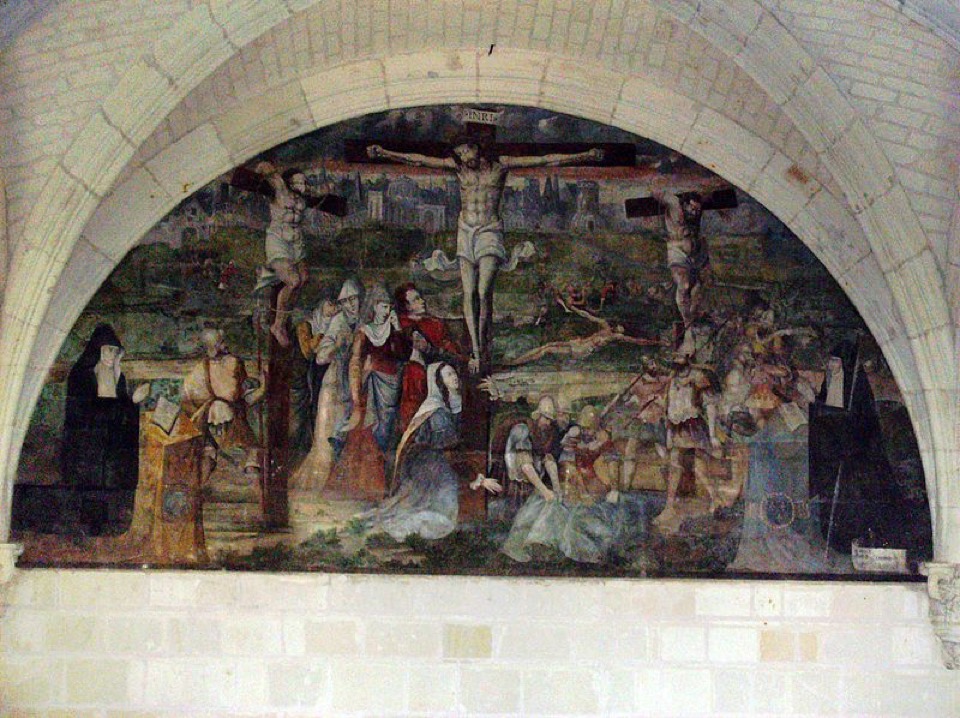
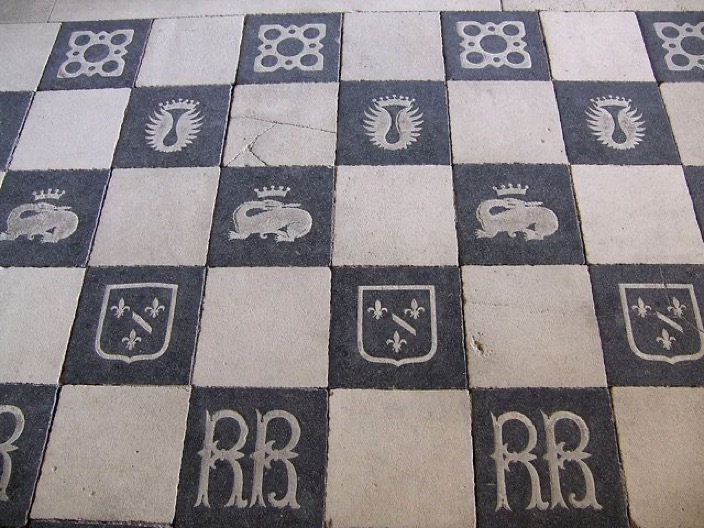
The floor is composed of white and black tiles, some encrusted with ‘rinceaux’, others with the salamander of François 1er, or the coat of arms (‘fleur de lis') of the Abbess Louise de Bourbon, or the initials “RB” of the Abbess Renee of Bourbon.

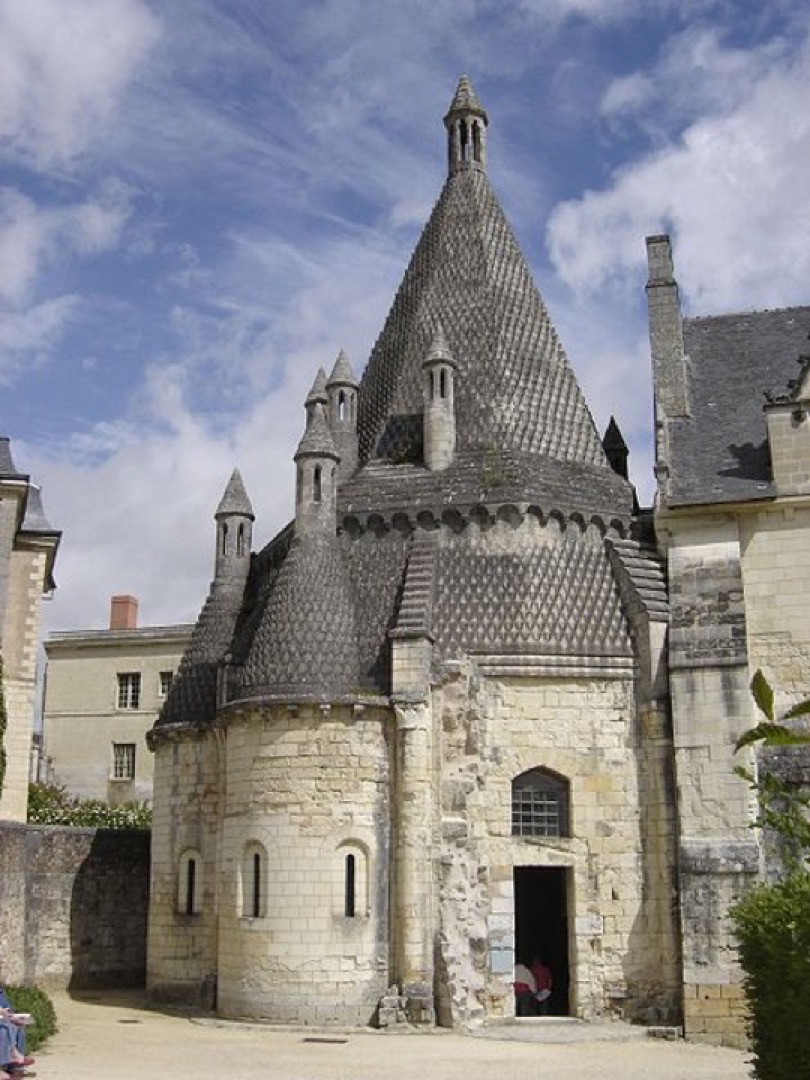
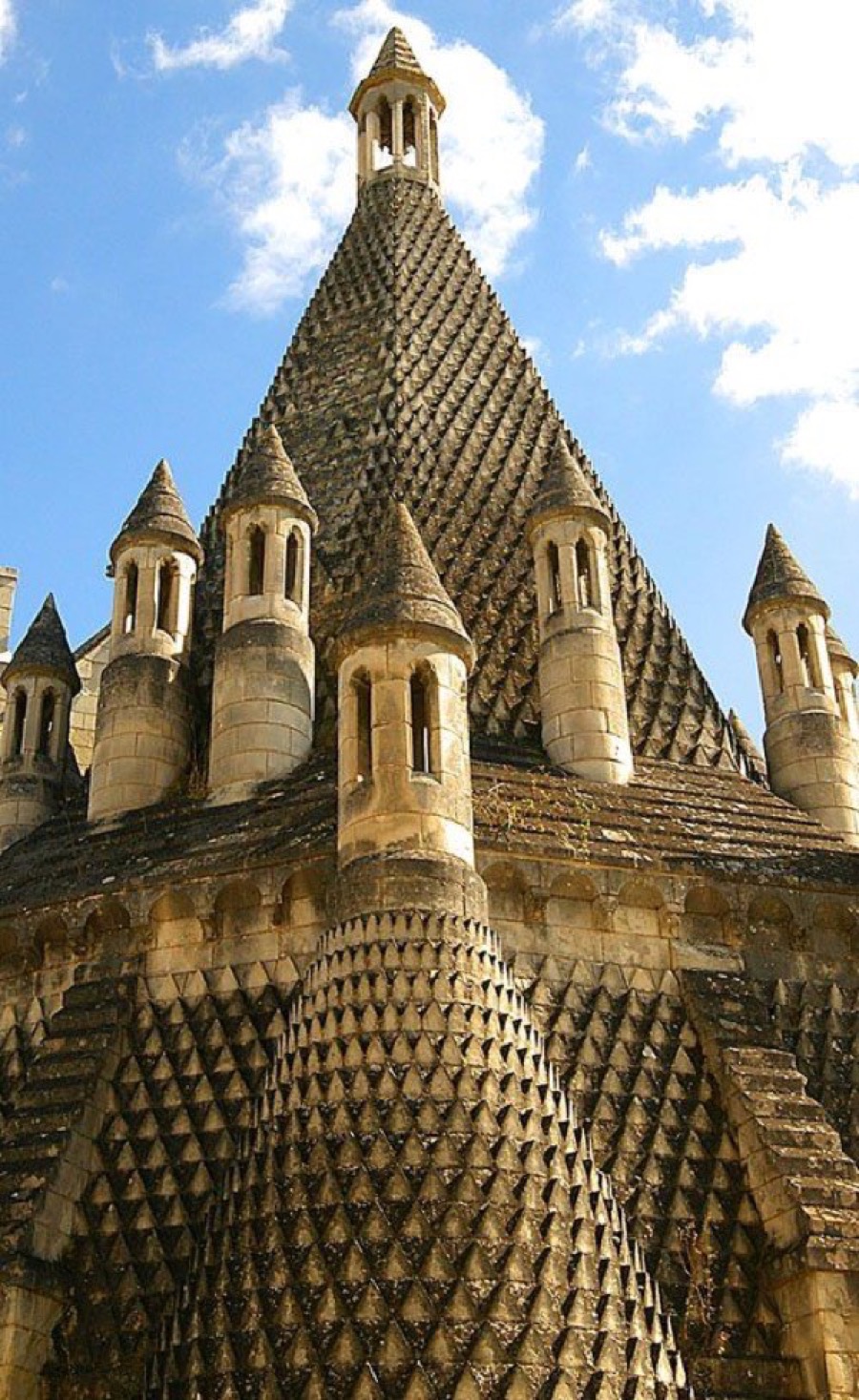
At the end of the refectory of there is a curious building. Some thought it to be a funerary chapel or a baptistery. It was even thought to have been the hideout of a legendary bandit. It was an English archaeologist who finally recognising it as a Romanesque kitchen. In the 12th century there were a dozen such constructions in the Benedictine abbeys located in the Middle Loire basin, but few survived.
We now know that it was originally built between 1144 and 1189 as a gift from Henry II. What we see is a large circular stone kitchen, including five ovens and twenty fireplaces necessary to feed the five hundred people living in the monastery in the 12th century.
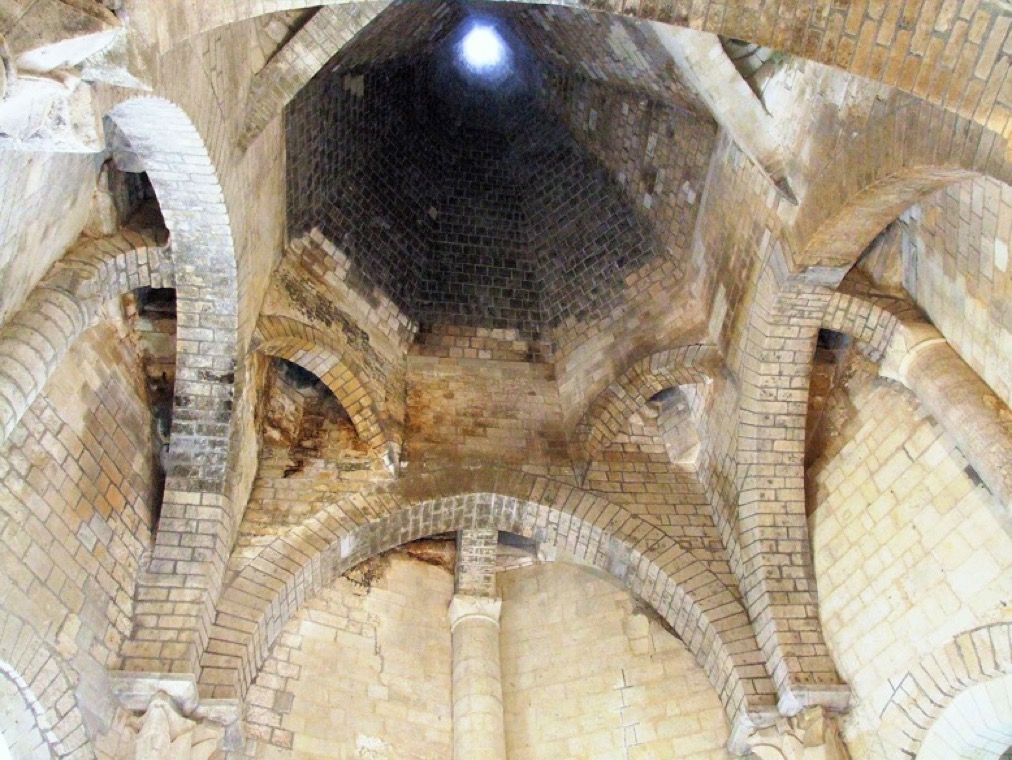
Originally, probably to avoid the risk of fire, the kitchen was independent, isolated west of the refectory. In the 16th century, it was decommissioned because of the construction of new kitchens. These were built as an extension of the refectory and attached to the original Romanesque kitchens.
Regarding the Romanesque kitchen, its construction technique is remarkable, only simple forms have been used to achieve this masterpiece of functional architecture. The base is an octagon where the hearths are arranged each with smoke ducts around a central duct. These external circular ovens were for smoking fish and meat. In 1902, during a ‘restoration’ windows were created in the ovens. The roof is made of stone in the form of fish scales, according to a typical Angevin habit.
In this ancient kitchen with its excellent acoustics there are the occasional chamber music concerts.
Just to highlight that restoration does not mean just trying to protect and/or recreate the past, below we can see the restaurant situated next to the hotel.
